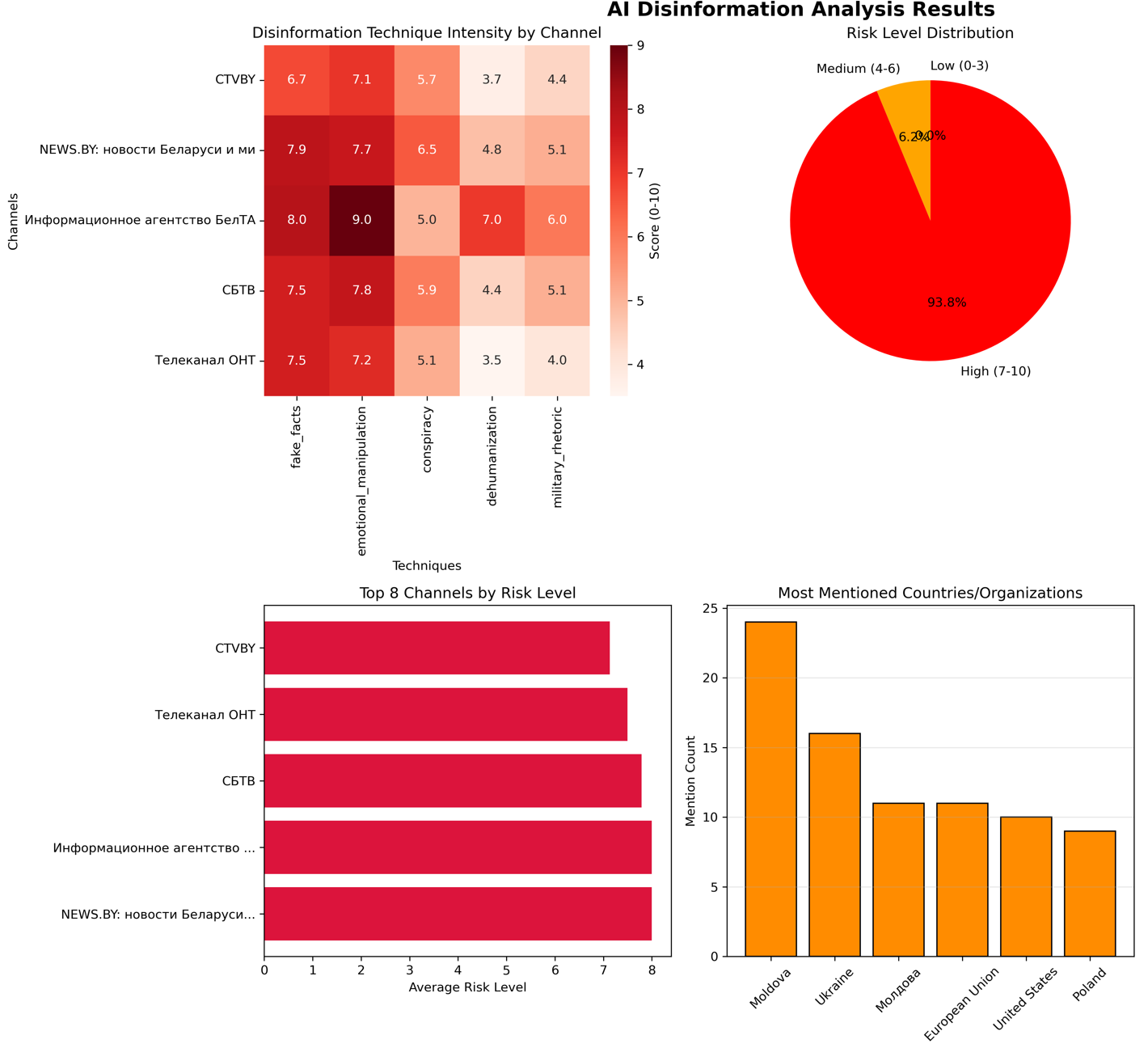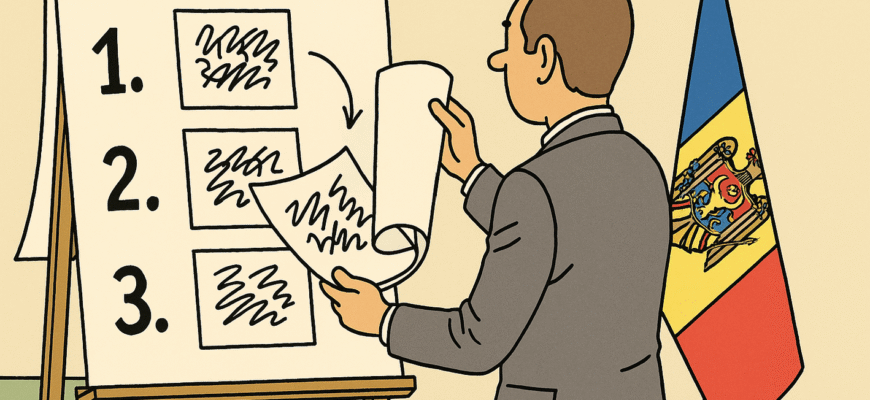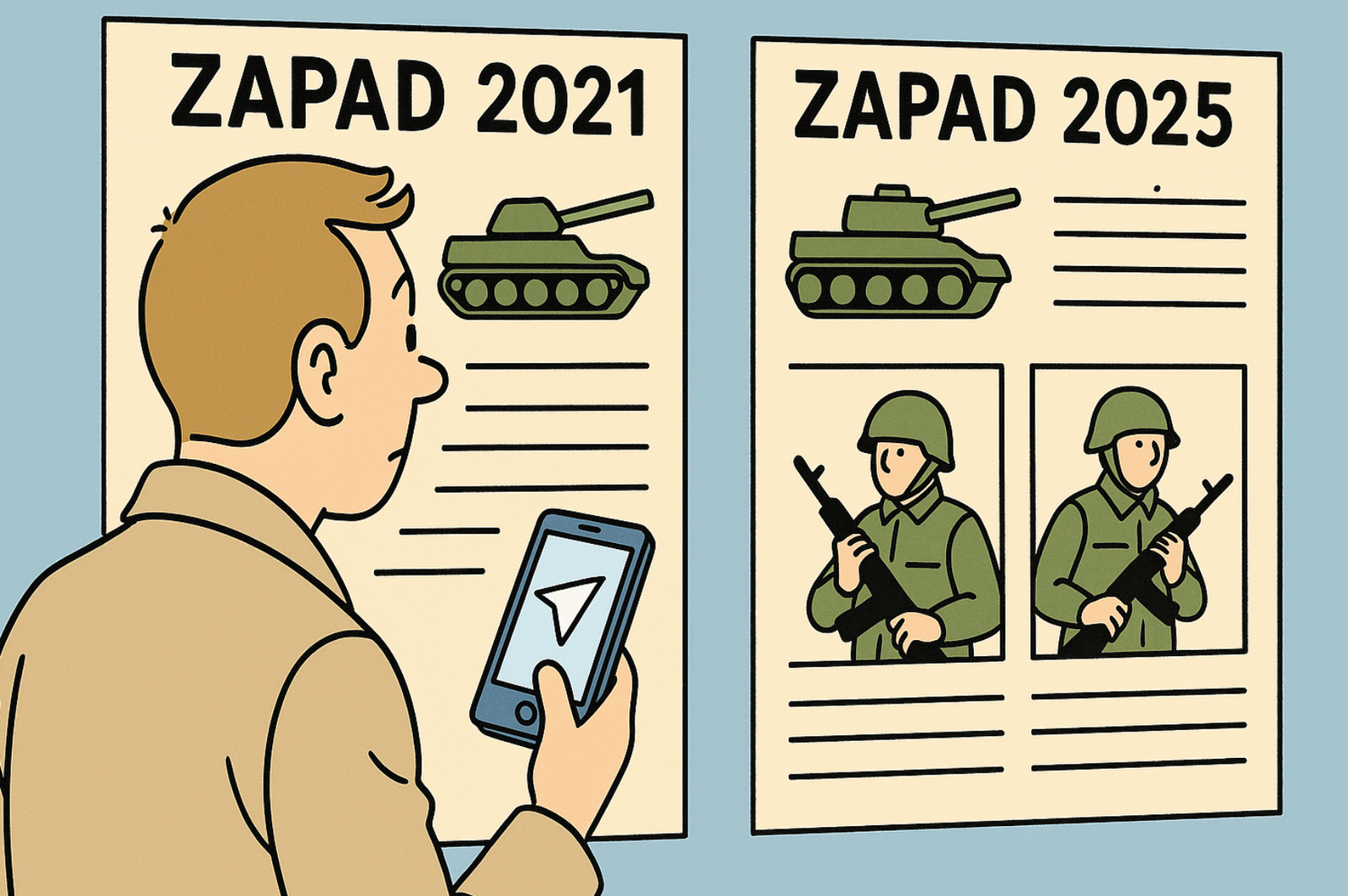Key findings of the study / TL;DR
This study revealed a systemic, three-phase disinformation campaign that Belarusian state media used to cover the parliamentary elections in Moldova. The campaign began several days before the vote and continued after the results were announced, with narratives not simply repeating themselves but evolving and adapting to each stage. During the pre-election phase, the foundation for mistrust was laid through themes of repression and external control. On election day, the focus shifted to direct accusations of fraud. After the results were tallied, the narrative transformed into a meta-narrative about the total illegitimacy of the results. This prolonged strategy creates a persistent perception among audiences that the elections were unfair and controlled from outside, requiring comprehensive countermeasures from the media, platforms, and the audience itself.
Conclusion: systemic, prolonged disinformation; measures for media hygiene and counter-communication are needed.
MethodologyThe analysis was conducted using metadata and full texts of YouTube videos from Belarusian state media. Methods of automatic sentiment analysis, thematic frame extraction, and temporal analysis were used. Disinformation narratives were analyzed and hypotheses for future classic fact-checking publications were developed.
Where LLM capabilities were used:
- video transcription into text;
- to assess disinformation risks;
- fact-checking.
Forty-eight videos were collected from five Belarusian state-owned media outlets on YouTube for the period from September 1, 2025, to October 13, 2025. These videos have garnered over 4 million views. Thirty-two videos are considered high-risk, and 50 statements require additional fact-checking.
Analysis results:

Visualization of the study’s results demonstrates the scale and nature of the disinformation campaign. An analysis of the intensity of various manipulation techniques reveals that Belarusian state-run channels systematically employed the full range of influence methods, with STV.BY, BelTA News Agency, and NEWS.BY being the most active. Emotional manipulation techniques are particularly dominant, with scores ranging from 6.0 to 9.0, indicating a deliberate strategy to influence audience emotions rather than rational thinking.
The distribution of content by risk level was critically asymmetrical. The overwhelming majority of the analyzed material—93.8%—fell into the high-risk category of disinformation, denoting the systematic use of false claims, conspiracy narratives, and manipulative techniques. Only 6.2% of the content was classified as medium-risk, and no low-risk materials were found. This concentration of high-risk materials indicates a targeted information campaign rather than random journalistic errors. The geographic focus of disinformation also revealed clear patterns. Moldova, as the study’s subject, predictably topped the list of most-mentioned countries with over 24 mentions, but significant attention was also given to Ukraine (around 15 mentions), the European Union, and other Western countries. This geographic map of mentions reveals a core narrative of a standoff between “Western-controlled” Moldova and alternative centers of influence, which serves as the basis for conspiracy theories about external election manipulation.
SetvideoHigh-risk and priority fact-checking requests.
Line of narratives
Based on the collected data, a three-phase narrative timeline was compiled.
Before Election Day (September 23–27)
Base frame:“Repression, ‘hysteria’ and external control – they are planning to steal the elections.”
-
September 23: Early warm-up – “Sandu Eliminates the Opposition / Romania’s Secret Plan” (CTVBY, Lazutkin). Theses on external influence and the “collapse of Moldova.”
Risk:7.0
Date:2025-09-23 17:20:01Fake facts7.0
Emotional manipulation8.0
Conspiracy theories6.0
Dehumanization4.0
Key statements:- Sandy’s electoral support is artificially inflated due to foreign interference.
- The electoral process in Moldova has fundamental flaws and is controlled by external forces.
- Romania is trying to undermine Moldova’s sovereignty through political and economic means.
- September 26: Episode series “Operation ‘Steal the Election'”: focusing on “mass arrests,” “political purges,” “government hysteria,” and references to the “operation in Transnistria” and even the “French military.”
Risk:
7.0
Date:2025-09-26 16:45:28Fake facts7.0
Emotional manipulation8.0
Conspiracy theories6.0
Dehumanization4.0
Key statements:- Moldovan authorities suppress dissent and manipulate elections.
- Foreign military forces interfere in domestic political issues.
- The EU ignores human rights violations in Moldova for geopolitical reasons.
- September 27: “The EU authorized repression in Moldova?!” — shifting responsibility to Brussels and heightening emotions (“Sandu’s brutality is shocking”).
Risk:
7.0
Date:2025-09-27 17:45:46Fake facts7.0
Emotional manipulation6.0
Conspiracy theories5.0
Dehumanization3.0
Key statements:- President Maia Sandu is manipulating elections to bring Moldova into line with the EU, to the detriment of Russia’s interests.
- The government has reduced the number of polling stations in Russia while increasing their number in Europe.
- The EU allowed repression in Moldova.
Phase summary:The audience is explained in advance the expected “election theft,” legitimizing the thesis of repression and external control (EU/Romania).
Election Day (September 28)
Base frame:“Scandal and falsifications right now.”
- Morning/Afternoon: “Scandalous elections in Moldova!” + key slogan “The government is burning opposition ballots!”; emotional formulas (“Moldovans are losing their homeland”).
Risk:
6.0
Date:2025-09-28 13:39:36Fake facts7.0
Emotional manipulation6.0
Conspiracy theories5.0
Dehumanization4.0
Key statements:- Election fraud in Moldova
- Burning of opposition ballots
- The daytime “Election Fraud!” newscasts churn out numbers without sources (“600 searches,” “dozens of arrests,” “50 violations,” “turnout >30%) and present this as evidence of “total control.”
Risk:
6.0
Date:2025-09-28 14:49:40Fake facts6.0
Emotional manipulation7.0
Conspiracy theories5.0
Dehumanization2.0
Key statements:- 2000 polling stations
- 101 members of parliament from 25 parties
- 600 searches and dozens of arrests
- Voting turnout has already exceeded the 30% threshold
- about 50 cases of violations
- A separate line is the diaspora: “Moldovans from Russia and Belarus are voting for the fate of Moldova,” which reinforces the motif of a “real people” outside the EU.
Risk:
5.0
Date:2025-09-28 15:00:36Fake facts3.0
Emotional manipulation6.0
Conspiracy theories2.0
Dehumanization1.0
Key statements:- Moldovans in Russia and Belarus vote on the fate of Moldova.
- Morning of September 29: “Moldovans furious over election results” (CTVBY) – generalized discontent and hints of protests.
Risk:
5.0
Date:2025-09-29 11:06:48Fake facts3.0
Emotional manipulation6.0
Conspiracy theories4.0
Dehumanization2.0
Key statements:- GDP growth in the CIS countries exceeds the global average.
- By the end of 2024, positive dynamics were observed in all Commonwealth countries.
- On September 29: “Who really decided Moldova’s fate?” — a twist on the conspiracy theory of external control (US/EU/Romania).
Risk:
7.0
Date:2025-09-29 15:22:16False facts8.0
Emotional manipulation7.0
Conspiracy theories6.0
Dehumanization3.0
Key statements:- The elections in Moldova were rigged and are illegitimate.
- Moldovan politics is under the control of foreign powers.
- There was significant voter suppression, especially in the diaspora.
- On the same day: “Moldova Divided by Election Results / Electoral Engineering” – a thesis about a “constructed victory” being formulated.
Risk:
7.0
Date:2025-09-29 15:55:57Fake facts7.0
Emotional manipulation8.0
Conspiracy theories6.0
Dehumanization3.0
Key statements:- The election results show a divided country and serious accusations of fraud.
- Western powers are accused of manipulating election results.
- The opposition appears ineffective and leaderless.
- September 30: Thematic episodes “What Happened to Moldova Under Sandu?” and “Why There’s No Country in Europe Poorer Than Moldova” reinforce the image of a “ruined, poor country under foreign control.”
Risk:
6.0
Date:2025-09-30 11:52:42Fake facts7.0
Emotional manipulation6.0
Conspiracy theories3.0
Dehumanization2.0
Key statements:- Moldova has severed relations with Russia and the CIS.
- Moldova is one of the poorest countries in Europe.
- Moldovan agricultural products are not needed in Europe.
- Parallel to this, “Results of the Parliamentary Elections… How the Sandu Regime is Fighting the Opposition” (NEWS.BY)—the final line: “elections stolen → regime → external occupation by the EU/US.”
Risk:
8.0
Date:2025-09-30 19:01:31Fake facts8.0
Emotional manipulation9.0
Conspiracy theories7.0
Dehumanization6.0
Key statements:- The elections in Moldova were seriously manipulated and were not democratic.
- Moldova is under creeping European occupation.
Phase summary:The narrative shifts from warnings to “online evidence” of fraud and dramatization of the process (“ballot burning,” “fraud”).
After the results are announced (September 29–30 and beyond)
Base frame:“The results are illegitimate; Moldova is being controlled from outside; the country is becoming poorer and is severing ties.”
Key findingsThis study reveals the complexity of the informational influence mechanism, which functions as a coherent system rather than a set of disparate manipulations. The key feature of the discovered pattern is its dynamic nature: disinformation narratives do not remain static, but rather undergo three distinct phases of transformation, each of which fulfills a specific function in the overall strategy.
In the first, preparatory phase, an informational context of mistrust and the expectation of violations is created. The audience is programmed in advance to perceive the elections as illegitimate through constant references to repression, accusations of external manipulation, and predictions of impending fraud. This stage creates the interpretive framework through which viewers will perceive subsequent events.
The second phase, coinciding with election day, transforms preliminary accusations into supposedly documented facts. The narrative shifts sharply from warnings to reports of ongoing scandals and fraud. The emotional intensity of the content reaches its peak, exploiting the urgency of the moment for maximum impact on the audience. Viewers receive confirmation of their expectations formed in the first phase, which enhances the effect of credibility.
The third, post-electoral phase represents the most sophisticated element of the scheme. Instead of a simple continuation of accusations, a narrative transformation occurs: individual “scandals” are integrated into a larger metanarrative about the systemic illegitimacy of not only the elections but also Moldova’s entire political course. Here, disinformation moves from the tactical to the strategic level, shaping the long-term perception of Moldovan politics as being controlled from outside and contrary to the interests of its own people.
The psychological effectiveness of this three-phase scheme is based on the principle of confirmation of predictions. When the audience first hears about impending violations, then sees their “documentation” in real time, and finally receives an “explanation” of the results through the prism of these violations, the illusion of a consistent and logical narrative is created. Critical thinking is suppressed by the apparent consistency of the information flow.
The scale of this campaign’s reach is particularly alarming. Over four million views of the analyzed videos indicate a significant impact on Russian-speaking audiences, including residents of Moldova itself, for whom these materials create an alternative information reality. Given the limited media pluralism in the Russian-language information space, such a volume of targeted disinformation poses a serious threat to the formation of an adequate public opinion on democratic processes.
The systemic nature of the discovered pattern indicates coordinated efforts and a unified strategy implemented through multiple channels. The synchronicity of the narrative phases, the uniformity of the manipulation techniques used, and the consistency of the main messages rule out the possibility of coincidence. This is the product of planning and centralized coordination of information policy.
Recommendations
Countering the identified three-phase disinformation scheme requires an equally systemic and multi-layered approach, one that takes into account the dynamic nature of information attacks and works proactively.
Media outlets and fact-checking organizations must radically rethink their response strategies. The traditional model of post-factum fact-checking, where a rebuttal is published after false information has been disseminated, is proving insufficient against sustained campaigns. Media outlets must develop a preventative approach, preparing explanatory materials in advance of predictable waves of disinformation. Ahead of significant political events, contextual materials should be published about the likely manipulative narratives, how to recognize them, and why they are false. On the day of the events themselves, promptness is critical: rapid fact-checks of highly viral claims should be published in accessible formats, such as short videos or infographics for social media. After the events are over, an in-depth analysis of the entire disinformation narrative is necessary, demonstrating the mechanics of manipulation and helping audiences develop immunity to similar schemes in the future.
Technology platforms and non-governmental organizations must take responsibility for creating early warning and rapid response systems. Information monitoring should track not only individual fakes but also the formation of narrative patterns, allowing for the prediction of the next phases of disinformation campaigns. Platform recommendation algorithms should be configured to prevent the spread of unverified and emotionally charged materials, especially during periods of political tension. Partnerships between platforms and fact-checking organizations should ensure the rapid placement of contextual labels and warnings on materials containing disinformation. Support for local editorial staff and fact-checking initiatives in regions most vulnerable to information attacks is critical, including training, technological support, and funding for their work during peak periods, such as election campaigns.
For the audience itself, developing media literacy and critical thinking is a key defense mechanism. However, these skills must be reoriented from recognizing individual fakes to understanding systemic manipulation. People need to learn to recognize recurring narrative structures, asking themselves why certain topics suddenly dominate the information space, how to verify the information presented, and what emotional reactions are being evoked. Educational programs should include practical exercises in analyzing information campaigns, demonstrating real-life examples of manipulation and its exposure. It is important to cultivate the habit of comparing information from sources with various editorial policies, verifying the original sources of quotes and data, and understanding the difference between reporting on an event and interpreting it through a particular ideological prism. Citizens must recognize that their emotional reactions to the news may not be spontaneous, but the result of deliberate influence, and develop the ability to pause before sharing potentially manipulative content.
Effectively countering complex disinformation schemes is only possible through the coordination of all these layers of defense. Media provide a credible alternative, platforms limit the spread of manipulation, and informed audiences become less susceptible to attempts at influence. Only such a comprehensive approach can create a resilient information environment in which democratic processes are protected from systematic attempts to undermine their legitimacy through controlled information campaigns.





















